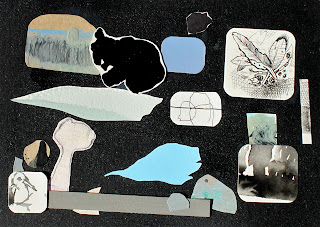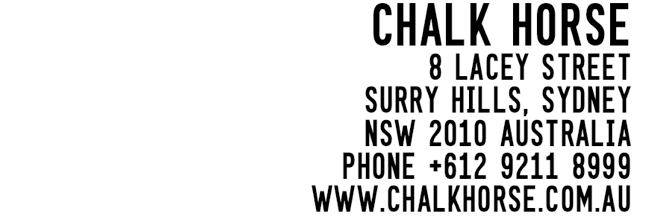Monday, October 31, 2011
Julian Meagher Recent Press
Julian Meagher was recently featured on Andrew Frost's blog The Art Life, showcasing some of the work from his exhibition 'The King of Good Times', 2011, at Edwina Corlette Gallery, Brisbane.
Meagher was also recently reviewed by Sallie Don in The Australian on the 17th of October, 2011. See image below.
Friday, October 28, 2011
Wednesday, October 26, 2011
SOPHIA HEWSON 'THE LONGING: IT'S LIKE VULCAN BUT SAD'
27TH OCTOBER - 20TH NOVEMBER, 2011
CHALK HORSE
“Certain thoughts are prayers. There are moments when, whatever be the attitude of the body, the soul is on its knees.”
- Victor Hugo, Les Miserables: Chapter IV, 1862
Sophia Hewson’s adoption of her subjects enables re-enactments of past histories and mythologies, which in turn offer an updated iconography. Highly finished paintings and sculptures succeed in conjuring the religious and mytho- logical, but on the other hand speak directly to an unmistakable Pop aesthetic. A dichotomy is being played out: the seriousness of the content is carried through the titles, yet they are also being confused by a kitsch presentation. I can feel myself forming (my borrowed rib), But like a slug I am mighty to men gives us a naked and crying Virgin Mary wearing a synthetic polymer veil, a fluffy halo and a plastic flashing heart around her neck, uncannily realistic in its rendering this character could well play a part in one of LaChapelle’s tableaux.
Aligning itself nicely with the Hyperreal of the 198O’s & 9O’s, Hewson’s painting presents the subject in a way that distances the object from the artist. Authorship is confounded, the ‘hand of the artist’ is not represented by a gestural brushstroke, and a thick layer of resin serves to further create a barrier between the signi- fier and the signified. Bound in a thick, syrupy resin, like prehistoric insects in amber, Hewson’s subjects are perpetually suspended, preserved and distanced. But almost paradoxically through this shiny surface, and iconicity, the Sublime and spiritual seem to be suggested.
Both the content and process embodied in these works pushes towards a cathartic redemption from an inexplicable, omnipresent, malady. Hewson attempts to find a means of genuine salvation and spiritual elation, and through doing so simultaneously captures the sadness or mourning that is embedded within the inevitable inability to find such fulfillment. This ‘longing’ is present in the show’s title which pays homage to a small planet thought to have been discovered by a French mathematician in the 19th Century. The planet, named Vulcan, was soon disproved to exist. This hypothetical world whose life was so short speaks of an ontological yearning for something that has not truly been lost but has left a void regardless.
It could be argued that in our secular and multicultural society shared values as outlined by the codex have dissipated and been replaced by the popular, the common, the everyday. Is Sophia Hewson’s art calling for a contemporary reading of religion and universal, traditional values? Or is it all surface, where Madonna is more likely to conjure the pop icon rather than the religious? Neanderthal Christ, suspended in a structureless crucifixion, carries the gravitas of Renaissance art history yet also taps into a shared knowledge: that of hundreds & thousands on fairy bread, or cupcakes, an ingredient that can be sourced from any supermarket.
Similar is her approach to Help me Saint Teresa of Avila, with the saint presented as a Renaissance-like tondo sculpture, carved by hand and then cast. St. Teresa, a Carmelite nun and Spanish mystic, is famed for the religious ecstasy she experienced during a bout of feverish illness. Outlined in her own writings, St. Teresa claimed four stages in the path to achieve union with God. These steps to ascent followed moments of increased intensity in mental prayer, culminating in “the devotion of ecstasy”, a climactic state involving the loss of consciousness to divine intoxication. Teresa claimed to have been visited by a seraph armed with a gold spear headed by a small fire, which he used to pierce her body numerous times, drawing out her entrails and leaving her in a state where “the pain was so great, that it made me moan; and yet so surpassing was the sweetness of this excessive pain, that I could not wish to be rid of it. The soul is now satisfied with nothing less”1.
It would seem that in the experience of the ‘unmanifested’, through sexual/spiritual ecstasy from tactile/cognitive sources, there is a reoccurring conjuncture with something darker that lurks beneath the surface. Perhaps it is the uncertainty of the experience, or the subconscious implications: the proximity between “la petite mort” and actual death, between pornographic orgasm and divine rapture. As Bataille says, “the bond between life and death has many aspects. It can be felt equally in sexual and mystical experience”2.
There is a tension in Hewson’s work between high seriousness and Pop, between pastiche and true experience. The work takes everything equally seriously, from the fashion photo to hagiography; as our contemporary experience takes in such a disorienting breadth. Hewson’s paintings and sculptures act as aides to help us understand and confirm the challenges of our late capitalist existence where we are often just set adrift, with little to hold onto.
- KAT SAPERA & OLIVER WATTS, 2O11
[1. St Teresa of Avila: El Castillo Interior, 1577
2. Georges Bataille: Death & Sensuality, 1986]
 |
| I can feel myself forming (my borrowed rib), But like a slug I am to mighty men, 2011, Oil & resin on board, 19O x 14Ocm. |
 |
| Help Me Saint Teresa of Avila, 2011, Hand-carved polyurethane, hundreds & thousands, resin, 7O x 7O cm. |
 |
| Neanderthal Christ, 2O11, Hand-carved polyurethane, hundreds & thousands, resin, 14O x 19O cm. |
Monday, October 17, 2011
Matthew Tumbers 'Spirit Hand Wandering'
18TH - 22ND OCTOBER, 2011
CHALK HORSE
THE WEATHER MAN
Matthew Tumbers’ hand rendering reveals a tight concentration that explodes with an intuitive approach to image making. The result is a powerful and influential alternative to conceptual art and popularised relational aesthetics.
Tumbers said in 2001 “it is difficult to make serious art in a period like this . . . if you are burdened with a goofy nature.”
For Tumbers though, the burden of his goofy nature is always tempered by an innate belief in the gestural, the intuitive and subconscious narratives that swim in his world. Where another may use mixes of known nouns, these abstract tools are his weapons of choice for expression. This sensitivity obliterates any ironic subtleties and creates a connectivity that was less apparent in his more detached tone conglomerates of the late nineties.
The profundity of the works lies in their genuine contemplation of the natural world wearing the goggles of the first child gazing in wonder at the fruits of the universe by the sea. One of the paintings included in this exhibition ‘National Parks for Caves’, exemplifies these concerns; a field of eggshell & grey brushstrokes references art historical archives of the abstract and successfully generates a depth of field via classical architectural construction to form a central yellow glow hole that envelops the viewer. Here, the primary subject of most Western painting - the human figure - is long gone, but spiritually close at hand. The sense of space generated in Tumbers’ mystic landscapes is like a transcendental meditation turning your brain inside out to find caves of experience and nature within.
In this exhibition Tumbers delivers a more minimalist approach compared to some of his previous exhibitions, guiding us into more ambiguous waters. With this comes time to reflect and swim with the tide of his intoxicating yet measured strokes. The rhythm of his riddle gives us more questions than answers about our identity in the ecosystem not only of nature but also in art. These paintings are in the same instance overworked and yet totally submerged in the act of painting.
As a kind of anomaly himself, Tumbers holds a sceptre to guide us through aesthetic philosophy buoyed through his compelling trance-like approach that is a wave, a nod, a thumbs up to the painterly.
- TIMOTHY VERNON MOORE, 2011
 |
| Duck Egg Blues, 2011, Acrylic, gouache, watercolour, pencil & ink on archival quality watercolour rag. |
 |
| Black Zoo, 2011, Acrylic, gouache, pencil & ink on archival quality watercolour rag. |
 | ||||
| Dusk Eavesdropper, 2011, Acrylic on archival quality watercolour rag. |
 |
| Rose Line, 2011, Acrylic on board. |
 |
| Hand Held Totem, 2011, Mixed media. |
 |
| Planking, 2011, Mixed media. |
To see more of the exhibition and Matthew Tumbers, visit Chalk Horse.
Wednesday, October 12, 2011
The Vasco Era Private Gig at Chalk Horse
LIVE PERFORMANCE AT CHALK HORSE
11TH OCTOBER, 2011
7 - 9PM
S.A.M.E. & Tenzenmen present The Vasco Era to celebrate the culmination of Sino Australian Music Exchange in a private advanced launch for their forthcoming self titled album. Transforming the traditional gallery space into a live musical performance space, The Vasco Era rocked the socks off the typically industrial Lacey Street and its neighboring residents.
Photography by Aimee El Sharpe
Subscribe to:
Posts (Atom)


























































